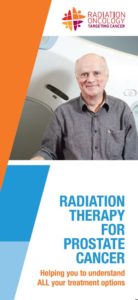Prostate Cancer

Every year around 22,000 men in New Zealand and Australia develops prostate cancer. It is the most common cancer diagnosis in many developed countries and occurs when abnormal cells in the prostate multiply uncontrollably and cause a lump or tumour. These cancerous cells can grow throughout the prostate and through the capsule surrounding the prostate. They can spread to sites well away from the prostate, such as the bones and lymph nodes, known as metastases or secondaries.
Prostate cancer is usually slow growing, although some cases can be more aggressive. As men are living longer and prostate cancer can cause many unpleasant problems and even death, treatment is often recommended to ‘cure’ the disease before it spreads outside the prostate.
If cancer travels away from the prostate region it can appear in bones and other organs. Although some treatment is likely still helpful, long term ‘cure’ is no longer possible. Therefore, early detection and careful monitoring and/or treatment are important for many men who have prostate cancer.
-
-
-
-
-
-
-
What Are the Causes of Prostate Cancer?
Only men have a prostate gland (beneath the bladder) meaning that women cannot get prostate cancer. The exact cause of prostate cancer is not known, however some factors are known to increase the risk.
Prostate cancer is rare before the age of 40, with the risk increasing substantially after age 50.
A strong family history of prostate cancer is associated with an increased risk, particularly in those with specific genetic conditions which are also associated with breast and ovarian cancer in women (BRCA mutations). The influence of diet on the risk of prostate cancer is unclear, however large amounts of red meat and dairy are thought by some to be associated with prostate cancer.
There are some variations between race and incidence of prostate cancer – as an example, Caucasian and African-American men have a higher risk of developing prostate cancer than Asian men.
-
What Are the Symptoms of Prostate Cancer?
Most men with prostate cancer do not have symptoms. Importantly, prostate symptoms including reduced strength of urine flow, getting up at night to pass urine, and daytime urgency to pass urine do not usually mean that someone has prostate cancer. However, as the cancer grows locally, changes in urination are more common.
In more aggressive disease, difficulty gaining an erection, pain or blood with ejaculation, and pelvic pain can occur. When prostate cancer has spread, then bone pain is a common presenting problem.
-
What Are the Treatments for Prostate Cancer?
Treatments aimed at curing prostate cancer can include external beam radiation therapy (EBRT or radiation therapy), brachytherapy, and surgery. The most suitable treatment will depend on many patient and cancer-related factors.
The patient should be helped to make a decision after discussions with specialists who manage prostate cancers. The urologist (surgeon) who usually makes the diagnosis using biopsies, and will discuss the surgical options and associated risks. The radiation oncologist will discuss the risks and benefits of their treatment options.
External Beam Radiation Therapy is often performed using Intensity-Modulated Radiation Therapy (IMRT), a modern technology allowing high doses of precisely targeted radiation to be delivered to the prostate with minimal impact on the surrounding tissues.
The most modern approach of IMRT uses Image-Guided Radiation Therapy to locate the prostate for each treatment to ensure millimetre treatment accuracy. External Beam Radiation Therapy is usually delivered once a day, Monday to Friday, over a number of weeks (usually 7 – 9 weeks). The treatment itself takes around 10 minutes per day to deliver.
The treatment uses X-rays, so patients are not radioactive at any stage. The benefits of External Beam Radiation Therapy include the ability to treat prostate cancer that has invaded through the capsule surrounding the prostate, or into tissues around the prostate, which is unlikely to be cured with surgery alone. There is no requirement for a stay in hospital and no need to recover from an operation.
External Beam Radiation Therapy (also called radiotherapy) can be combined with 6-24 months of hormone treatment, shown in scientific studies to increase treatment cure rates for more aggressive forms of prostate cancers.
Prostate brachytherapy involves implanting radioactive ‘seeds’ or sources into the prostate, which deliver targeted radiation to kill cancer cells. The seeds can be implanted permanently and deliver radiotherapy slowly over a long period of time. This is called Low Dose Rate Brachytherapy (LDR).This form of brachytherapy is usually used for low to intermediate risk prostate cancer.
High Dose Rate Brachytherapy (HDR) moves a radioactive source into different positions throughout the prostate, with the help of a special machine. The radiation is delivered rapidly and can be used alone, or in combined with a short course of External Beam Radiation Therapy. It is often used for more aggressive prostate cancers.
Surgery to remove the entire prostate is called a radical prostatectomy and can be performed with an incision in the lower abdomen or assisted with cameras inserted through small holes in the abdomen (laparoscopy). Some centres perform robotic prostatectomies, which is a special type of laparoscopic procedure which involves the surgeon controlling surgical tools at a distance from the actual patient.
If the prostate cancer is seen to have extended beyond the prostate capsule after surgery, radiation therapy may be required to treat the prostate cancer left behind.
If cancer cells have travelled further outside the prostate (metastasised), it is still treatable, however long term ‘cure’ is not possible. Androgen deprivation therapy (ADT) is a form of hormone therapy which can be used to lower testosterone levels with injections into the belly fat or with tablets. This treatment is often used to slow down or control the cancer before or after it has spread from the prostate.
External Beam Radiation Therapy is also very effective when treating any painful metastases and is commonly used if the prostate cancer has spread to the bones.
Chemotherapy and other drug treatments can be used later in the course of prostate cancer treatment, especially after hormonal therapy becomes ineffective.
-
How Effective Is Radiation Therapy for Prostate Cancer?
All conventional options (surgery, radiation therapy or brachytherapy) offer the same chance of cure for the same cancer.
The effectiveness of ‘seed’ brachytherapy for early prostate cancers is now accepted as being at least as good as radical prostatectomy, with overall lower side effects, better quality of life and equal survival rates to surgery.
The effectiveness of external beam radiation therapy for prostate cancer appears to be at least as good as surgery, with recent dramatic improvements in modern radiation therapy techniques occurring as a result of innovative technology. These advances have allowed radiation therapy to be more accurately targeted to the site of cancer, reducing the chance of serious side effects and allowing higher doses of radiation to be delivered to the tumour (dose escalation).
In the case of prostate cancer, this ‘dose-escalation’ has led directly to more cancer cells being killed and higher cure rates compared to 15-20 years ago. This is why it is very important that men have talked to a radiation oncologist about this management option and its associated risks and benefits.
-
What Are the Side Effects for Radiation Therapy?
Side effects during/soon after treatment (Early or ‘acute’ side effects)
General – Fatigue is quite common in the second half of treatment and is very variable between patients. It may be worse for men on both hormone therapy and radiation therapy. Fatigue can persist for a few weeks after treatment, but as for other early side effects, this has usually settled within 4-6 weeks after radiation therapy is completed.
Local – All other side effects of radiation therapy come from the structures/organs in and just next to where the radiation is being targeted. For the prostate this means the bottom of the bladder, the urethra (the tube through the prostate where urine passes) and the front part of the rectum (lower bowel). These can commonly cause the following side effects, which usually have fully settled by 4- 6 weeks after treatment is finished.
Bladder/urethra – in weeks 3-4 of treatment it is common to start to get some or all of the following: increased frequency of urine, especially at night; stinging or burning while passing urine; a sense of not fully emptying the bladder; a poorer stream than before. These symptoms are usually mild to moderate but can be worse if there were significant urinary problems before treatment.
Rectum – Bowel motions may become more frequent in the second half of treatment or there may be a need to go more frequently or urgently to open the bowels. There may be some more mucous discharge, excess wind and/or discomfort on opening bowels. Diarrhoea is very uncommon.
What can help reduce side effects?
Resting as needed can help with fatigue though some men find regular exercise helps as well. During treatment patients are given advice about their bowels and bladder and are encouraged to drink plenty of water especially in the earlier part of the day and to keep the motions soft and easy to pass. Over the counter medicines can help with burning and stinging when passing urine. If bowel symptoms are more severe, suppositories can be prescribed by the doctor but this is quite unusual with modern radiation therapy. These side effects are rarely severe with modern targeted radiation therapy and commonly settle soon after treatment.
Side effects well after treatment (Late or long-term side effects)
Late side effects may occur a few months or years after treatment though they are much more rare than early side effects. Depending on the problem these may occur once and then go or may be more persistent over the long term or may come and go over time.
Local side effects
Bladder/urethra – Incontinence is very rare after radiation therapy alone but is more common when combined with surgery. Tightening of the urethra with scarring (stricturing) occurs in about 2-3% of men having radiation therapy alone. Bleeding from abnormal blood vessels in the bladder as a result of previous radiation therapy is not common but is seen in some cases, and needs to be investigated to exclude things like bladder cancer.
Rectal (lower bowel) changes from radiation therapy can cause (usually minor) change in bowel habit, excess mucus production, or bleeding in <10% of men (though this does not necessarily occur all the time). These symptoms can be severe enough to significantly impact on long term quality of life less than 5% of the time.
Sexual function (erections) can be reduced over time after radiation therapy (more so if men are on hormone treatments), especially if there were issues before treatment. For men with ‘normal’ sexual function pre-treatment, erections can be negatively affected over time in around half of all cases, although there may be many other factors that affect erectile function. The volume of the ejaculate and quality of the orgasm can reduce. Fertility is affected negatively in most men, but sperm storage can be organised pre-treatment in those men who have not yet completed a family.
Any exposure to radiation increases the risk of a second cancer developing in that area, usually decades later. This risk is not entirely attributable to radiation received as part of your treatment. All X-rays and scans received over your lifetime contribute to this risk, as does unavoidable exposure to environmental radiation. The risk of a cancer being caused by radiotherapy is in the order of 0.5 – 1% at 10 years.
What can be done to treat late side effects?
Bleeding from the bladder or rectum can be treated with techniques that use laser to close up bleeding blood vessels if this problem persists. This is especially effective for rectal bleeding. Dietary measures can help if the bowel actions become more urgent or frequent over the longer term. Stretching of urethral strictures by a urologist can alleviate a weakened urine stream. Medical treatments can be used to improve erections after a discussion with your doctor (tablets and/or penile injections).
-
How do I enquire about radiation therapy with my healthcare professional?
The correct person to talk about the role of radiation therapy treatment for prostate cancer is a Radiation Oncologist. You can ask your Urologist or General Practitioner for a referral to a Radiation Oncologist to discuss whether radiation therapy is a good option for you.
Visit ‘For GPs and other Health Professionals’ and ‘Talking to your doctor’ sections for further information.
Find your closest radiation oncology Treatment Centre
Useful Resources
ABC Radio Canberra, Interview with David Letts, Prostate Cancer Survivor and Associate Professor Sandra Turner, June 2017
Catton CN, Lukka H, Gu CS, Martin JM et al. Randomized trial of a hypofractionated Radiation Regimen for the Treatment of Localized Prostate Cancer DOI: 10.1200/JCO.2016.71.7397 Journal of Clinical Oncology, 15 March 2017
Haines Ian. The scandal of prostate cancer management in Australia Medical Journal of Australia Issue 45, 21 November 2016
Hamdy FC, Donovan JL, et al. Prostate Testing for Cancer Treatment (ProtecT) Trial Study Group, 10-Year Outcomes after Monitoring, Surgery, or Radiotherapy for Localized Prostate Cancer. The New England Journal of Medicine, 14 September 2016
Prostate Cancer Treatment Options Cancer Institute NSW Fact Sheet, June 2016
Comparing Treatment Results Of Prostate Cancer- Prostate Cancer Results Study Group- Updated June 2015
LDR Brachytherapy: Latest Advances In Prostate Therapy Treatment- BJUI Supplements
Videos
What is brachytherapy and how effective is it for prostate cancer? Interview with A/Prof Jeremy Millar, Director, Radiation Oncology, Alfred Health
What are the indications for radiotherapy for distant metastatic disease? Interview with A/Prof Jeremy Millar, Director of Radiation Oncology, Alfred Health
Donald Patterson was the 400th man to be treated with LDR brachytherapy. View his experience.
-
Other Resources
Radiation Therapy for Prostate Cancer, Targeting Cancer, April 2017
- Informed Decision Making in the Management of Localised Prostate Cancer Position Paper, RANZCR, June 2018

-
-
-
-
-
-



